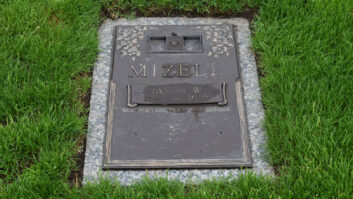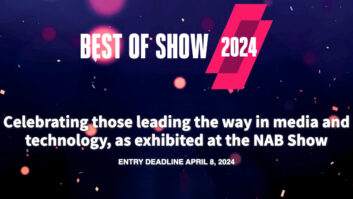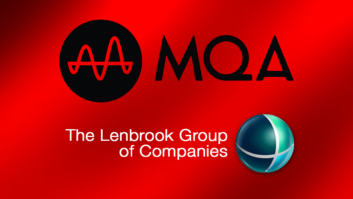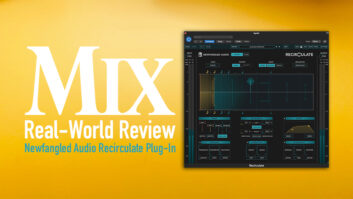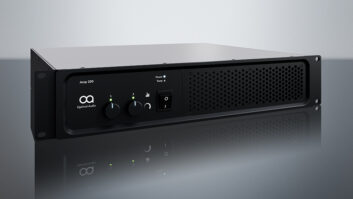I wonder how many of you out there watch TV. More specifically, how many of you watch via over-the-air television reception? How about your mom or bro? If things move forward as planned, in about 20 months, give or take a few, all those folks are going to be staring at lovely, random snow patterns because there will be no more signal. In keeping with the planned transition to digital television, analog transmissions must cease at some point so Our Enlightened Government can auction off the spectrum to the highest bidder.
Where will that leave a significant portion of the U.S. viewing audience? Up the proverbial creek without a paddle, outta luck, high and dry. My household will be one of those. Left out of the water-cooler conversations about the latest manufactured culture. Tragic. So what will we do?
This month, I’d like to bring your attention to a slow sea change that may affect your audio artistry. If you are involved in broadcast teleproduction, then begin thinking about how you can either find another gig or attract new clients, because the middle age of broadcast TV has passed and that ol’ dog is in slow decline.
Why the dire prediction? In keeping with the core theme of this column, it’s those doggone computers that did it.
Once upon a time, Japan implemented a national “high-def” TV system — an analog high-def system. Not long after, the Europeans and us decided to go with a digital version as digital “is better.” Because we, the American people, cannot force ourselves to adopt something that the Europeans have even touched, we went with a unique system. However, since the 1950s, when the NTSC color standard was created, the political climate has changed and the rise of lobbyists in Washington, D.C., has attenuated the Voice of the People to the point where you need a rather high-gain preamp to even pick it up.
The result is our current Federal Communications Commission — mandated digital TV standard, which is so vague as to be laughable. Our Appointed Officials’ singular lack of backbone regarding standards setting has produced a morass of costly production and delivery infrastructure and overpriced consumer electronics that couldn’t interoperate if they tried. Then comes the deathblow: retiring analog over-the-air service.
In February 2005, the FCC came to a “tentative conclusion not to impose a ‘dual-carriage’ requirement on cable operators [which would have required them to simultaneously carry broadcasters’ analog and digital signals] and affirmed the Commission’s prior determination that cable operators are not required to carry more than a single digital programming stream from any particular broadcaster.” Woosh, woosh…plop. That’s the sound of TV watchers falling away from network viewing as they lose the ability to receive the Big 3’s, er, Big 4’s signal.
Okay, so urban and suburban viewers, mostly on cable, will lose some or all of their broadcast programming. No worries, there are 100 other channels. After a time, they won’t care anymore.
Then there’s the rural population. They can easily afford those new $2,000 DTV receivers needed when the analog shutdown occurs. Yeah, right — I know, the cost of DTV adapters and DTV-ready tellies will come down in time, but by that time, the people won’t care anymore. Nobody will care if network TV lives or dies.
Linux, PVRs, BitTorrent, DVDs, broadband, vlogs and their slavish handmaiden, RSS feeds — all of these computer-based technologies will converge to close the gap left open by increasingly irrelevant broadcast content. I don’t know about you, but the only time I listen to or watch broadcast is when I’m in the car and, dude, I don’t have a TV in my car. In other words, I listen to my local NPR affiliates when driving short distances, but podcasts and my rather modest collection of lossy audio are pressed into service on long trips. That’s it. This family consumes little other broadcast programming.
Now, I know I may be atypical, but not for long. As access to over-the-air signals becomes increasingly difficult or costly to receive and broadband creeps across the land, consumers will either turn to other free content or will opt for low-cost, fee-based programming that meets their needs. If and when broadcasters figure out how to compete in this increasingly hostile environment, they won’t have an audience. Think AM radio.
I’m curious. Though you, the Mix readership, are in the media business, I’ve found that few of you possess modern entertainment systems in your home. So I ask, how many of you are up that creek I mentioned earlier? Are you planning on buying an ATSC-compliant receiver when analog service is sacked? If your cable service didn’t carry broadcast channels or if you don’t have cable, then would you or your household really care that CBS or NBC or Uncle Rupert was out of reach? Would your world end without a weekly dose of CSI?
I’ll leave you with two words: wearable computers. Whether it’s a sixth-generation iPod or a Samsung/Rossignol collaboration, wearables are finally getting good. Ed Thorp and Claude Shannon’s little Vegas gambling experiment of 1961 has slowly evolved through improvements in power, storage, input and display technologies and into a viable choice not for beating the house (that was banned in 1985), but for portable entertainment products of the future. Mess with a PSP next time you’re in a retailer and you’ll see what I mean.
And now for some holiday leftovers.
If you are of a certain age, you remember Supertramp. Their music filled the airwaves all through the ’70s. Some 30 years on, one of their latter-day guitarists, Carl Verheyen, is still an effortless player and staple session musician, and now he’s the subject of a new AIX dual-DVD disc super-set. This release is an example of how a music DVD should be done. In brief, “…no artificial reverberation is ever added to our tracks…Miking is extensively done with stereo pairs to provide depth of image,” says Mark Waldrep, maestro of AIX Media Group. “We use lots of tracks, great mics [and] mixing is handled completely in the digital domain.” The result: a DVD-V and DVD-A combo with clean, unobtrusive production, more extras than you can shake a remote at and convincing audio that documents the performances. If you like guitar rock or know someone who does, this set is for you.
Next up, armor plating. Do you take your PowerBook on the road and beat the crap out of it? If you want some serious protection — and none of this wimpy closed-cell foam stuff — then take a look at RadTech’s (www.radtech.us) MacTruck. I know, this sucka weighs as much as the computer, but it’s built like the proverbial brick house. All aluminum, but not as prissy as a Halliburton and half the price.
In the “You don’t know you need it until you get one” category is Cepstral’s (www.cepstral.com) third-party voices for popular operating systems. I’m not talking synth voice; I’m referring to text-to-speech synths, and, no, they don’t sound like Stephen Hawking anymore. If you want to convert a Project Gutenberg EText to spoken word for a long trip or you just want to give one of your secondary computers a distinctive voice should an alert arise, then give these cyberians a try. Cepstral William, derived from the vocal stylings of Cepstral’s president, Kevin Lenzo, has become my default voice for all my PowerBook utterances. He’s cool, distinctive, nicely priced and, most of all, intelligible.
Speaking of nice price, you’ve got to check out Katsura Shareware’s (www.katsurashareware.com) AudioTest for Mac OS. It’s a great test-tone generator, with capabilities that far exceed the $10 price. Another audio essential for your toolkit, along with AudioTest and the ever beautiful Soundhack, is Rogue Amoeba’s (www.rogueamoeba.com) Audio Hijack Pro. Just throw down for it.
On to another more concrete subject: ergonomics. I know, Apple finally came out with a multi-button mouse, but, sorry, it still can’t touch Contour Design’s (www.contourdesign.com) Perfit mice. If you hold a damn mouse all day, then you owe it to your extremities to test-drive one of these little fellers. They make ’em in USB, ADB, PS2 and 9-pin serial versions!
While we’re at it, let’s talk keyboards. Again, if you spend all day in front of a computer, then don’t put up with junk gear. Get yourself a quality keyboard — you’ll never go back. For you Win kids with the PS2 thing, check out Creative Vision Technologies’ (www.cvtinc.com) CVT Avant Stellar. For you Mac kids, check Matias Corp.’s (www.matias.ca) Tactile Pro. For you fence-sitting, cross-platform radicals, check out Datadesk’s (www.dbz.com.au/lf/default.htm) TrackBoard product, a combo keyboard and trackball. All these keyboards use mechanical — as opposed to membrane — switches with tactile feedback; very nice feel and more durable than throwaway keyboards.
We’ve all seen those two-tiered paper trays that folks use to hold and organize incoming paperwork, track sheets or other ephemera. Well, the guys at Pressure Drop (http://pressuredropinc.com) thought real hard about maximizing space — some might say a bit too hard — and came up with the Black Diamond PaperHub, a glossy black-on-aluminum two-tier job with built-in, powered four-port FireWire 400 and USB 2 hubs — cyber-organization for the chronically disorganized.
For those who fret about what’s on their iPod and what woes may befall those contents should said little media player fall into unfriendly hands, I submit for your inspection two utilities: Prosoft Engineering’s (www.prosofteng.com) TuneTech and AlienCrypt’s (www.aliencrypt.com) eponymous AlienCrypt encryption utility. Along with backing up, optimizing, repairing, undeleting and several other functions, TuneTech will “shred” songs and files, preventing subsequent recovery should someone gain access to your ‘Pod. AlienCrypt provides an inexpensive, easy-to-use, drag-and-drop method of encrypting files. Hey, stuff gets lost in transit, ‘nough said.
Are you one of those people who spends way too much time geeking and not enough time interacting with others of your species? Do you have some old iPods lying around, waiting to place that Craigslist ad you never seem to get around to? If you answer yes to both of these questions, then you need iPodLinux.org. Yup, Linux on your iPod, dual-bootable no less!
More seeming fluff I admit, but this is another item that adds a bit of whimsy to my day. The mad (in a good way) folks at Speck Products (www.speckproducts.com) gave me an iGuy, and this boing-y little feller has proved to be tough, non-slip and fun to have around. Granted, iGuy’s not as fuzzy as the Old Navy zero-to-three-month infant sock that DJ Jonah Jone has donated to my iPod protection racket, but the iGuy’s more than up to the task of protecting against the ongoing assaults that my player falls victim to.
Okay, if you think a silicone, posable iPod case is messed up, which, frankly, I don’t, then you haven’t seen nothin’ yet. The Trader Vic’s crowd now has a reason to celebrate since the folks at TikiMac (kilauea.tikimac.com) have released the hand-painted Big Tiki Drive, in sizes from 0.5 to 4 GB. Not just for storing and transporting Arthur Lyman remixes, the Big Tiki is a well-rounded USB 2 Flash drive with a built-in “aura” access light and included “Lava USB” cable. You better have your war club nearby when your second sees this bruiser because he’ll want it for his own.
So that’s it for now. Next time you hear from me, I’ll be checking in on the Apple/Intel cabal.
Oliver’s been catching up on his old-media entertainment: Bruce Sterling’s Holy Fire, a ripping good read, and Sigur Rós aural explorations of the finer points of analog.
Oops, I Did It Again
Several times in the past, the United States has picked an inferior electronic distribution standard. First it was monochrome television, then our “Never the Same Color” service and, later, the current FCC-mandated, ill-conceived and implemented digital television system.
Well, surprise, it’s happening again with terrestrial digital radio. We’re getting our own HD radio system while the rest of the world, it appears, is adopting the Digital Radio Mondiale standard. The HD radio implementation came at the expense of low-power FM spectrum, and that grab for spectrum will also further degrade the already pallid analog AM radio we are now accustomed to. Stupid is as stupid does, I’d say.
— OMas

